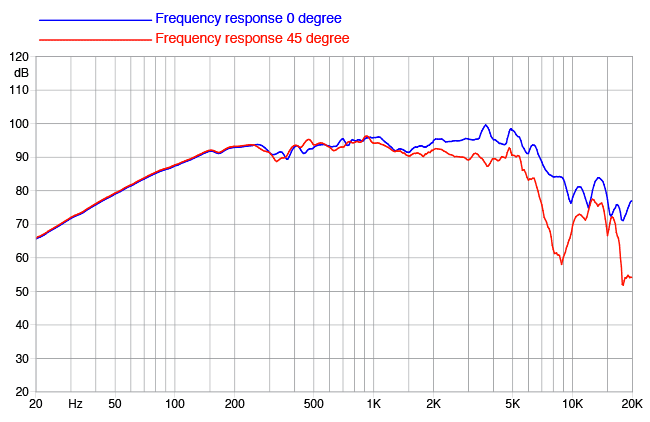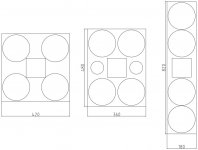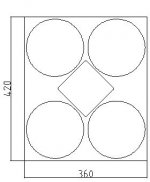Another thought, if your looking for the ultimate in compact coaxial drivers are very attractive. Expensive for the good ones though. Also I would recommend going 3 way with them to avoid the waveguide come moving too much. I had an idea for a speaker in the form of a cube with the low frequency driver on the side of the box, sealed and with a lot of power. About 5x the cost of the 4*6" idea though!
The killer is the directivity plots, very few coaxs have nice polar responses. I don't know about the rcf one but b&c sell similar coaxs which have polar plots that you can look at. From memory the good looking ones where the 15" drivers that used the cone as the waveguide but these are very expensive.
I found some picture of typical transitions in coaxial driver:
https://www.diyaudio.com/forums/multi-way/270501-detriments-coaxial-woofer-3.html#post4243784
pretty ugly those sharp discontinuities cause diffraction which mess up the polar response you also get diffraction around the horn in the type like the RCF with a fixed horn.
The Denovo from DIY sound group managed to fix this to get good polars:
Vortex Speaker Kits | HiFiCircuit
its unclear if there is something special about their drivers or if its the same driver as the KL3015CX-8. I would suspect considering the cost of custom machining and the pointlessness of making a driver that performs worse their driver probably has the same transition as the normal version...
https://www.diyaudio.com/forums/multi-way/270501-detriments-coaxial-woofer-3.html#post4243784
pretty ugly those sharp discontinuities cause diffraction which mess up the polar response you also get diffraction around the horn in the type like the RCF with a fixed horn.
The Denovo from DIY sound group managed to fix this to get good polars:
Vortex Speaker Kits | HiFiCircuit
its unclear if there is something special about their drivers or if its the same driver as the KL3015CX-8. I would suspect considering the cost of custom machining and the pointlessness of making a driver that performs worse their driver probably has the same transition as the normal version...
If you put the 4x 6.5" drivers in a square, you get approximately the off axis response of a single 15" driver; narrowing at ~ 1kHz.
Edit: The comb filtering from drivers in the horizontal plane is much more noticeable then the same combfiltering in the vertical plane because our ears are in the horizontal plane.
I would put them in a vertical line with the tweeter in the middle: MMTMM then you get the horizontal off axis response of a single 6.5" (narrowing at ~2.5kHz and the vertical of axis response from a (4x 6.5"+tweeter) ~ 30" or 2x15" driver; narrowing at ~500Hz. Which will match a CD horn or ribbon/planar/AMT tweeter quite nice.
If you use a tweeter with more height then the 6.5" mids, then you start to get nasty vertical comb filtering and you are probably better off with the tweeter on top; TMMMM. That also depends on the crossover frequency but the closer the mids, the better.
You can also use a line of tweeters, i.e. a line of planers in front of the mids. But then the high end of the tweeters is as loud as a single tweeter due to comb filtering and you will have to EQ that back in. Which is not a big problem as there is not much energy in the highest frequencies. Video about line point source and line array/source speakers.
I would not use a line of coaxials as that will be a combfiltering disaster; a big suck out of the top end.
Edit: The comb filtering from drivers in the horizontal plane is much more noticeable then the same combfiltering in the vertical plane because our ears are in the horizontal plane.
I would put them in a vertical line with the tweeter in the middle: MMTMM then you get the horizontal off axis response of a single 6.5" (narrowing at ~2.5kHz and the vertical of axis response from a (4x 6.5"+tweeter) ~ 30" or 2x15" driver; narrowing at ~500Hz. Which will match a CD horn or ribbon/planar/AMT tweeter quite nice.
If you use a tweeter with more height then the 6.5" mids, then you start to get nasty vertical comb filtering and you are probably better off with the tweeter on top; TMMMM. That also depends on the crossover frequency but the closer the mids, the better.
You can also use a line of tweeters, i.e. a line of planers in front of the mids. But then the high end of the tweeters is as loud as a single tweeter due to comb filtering and you will have to EQ that back in. Which is not a big problem as there is not much energy in the highest frequencies. Video about line point source and line array/source speakers.
I would not use a line of coaxials as that will be a combfiltering disaster; a big suck out of the top end.
Last edited:
Think, what is the formula for the directivity of a piston driver? I know there is one that says how many degrees at which frequency, but could not find it. I only remember the rule (hope correctly) that beaming starts at half the wavelength.
Was there also any software that would calculate the polar responses with different driver arrangements and crossover?
Below is a sketch of the front baffle options with a small 70*70 waveguide mentioned before, it is usable down to 2 kHz (if I interpret the linked measurements correctly) and better be crossed over at 2.5 kHz. Visually, I like the middle one the most.
Was there also any software that would calculate the polar responses with different driver arrangements and crossover?
Below is a sketch of the front baffle options with a small 70*70 waveguide mentioned before, it is usable down to 2 kHz (if I interpret the linked measurements correctly) and better be crossed over at 2.5 kHz. Visually, I like the middle one the most.
Attachments
I think Software virtuixCAD can do it or if your looking for something quick to get an idea Tolvan Data .
Narrowing starts where the wavelength is less then the (effective) width of a driver. Wavelength calculator
Faital Pro produces often good very good 45 degree off axis responses next to their on axis response. I suspect this has something to do with the shape of their cones, but it can also be that they lose some output in between 0 and 45 degrees off axis compared to others.
To bad most manufactures like Eminence don't publish any off axis data. But here is the Alphalite6a

and the 6FE200 (watch the vertical divisions in the graph)

Faital Pro produces often good very good 45 degree off axis responses next to their on axis response. I suspect this has something to do with the shape of their cones, but it can also be that they lose some output in between 0 and 45 degrees off axis compared to others.
To bad most manufactures like Eminence don't publish any off axis data. But here is the Alphalite6a

and the 6FE200 (watch the vertical divisions in the graph)

I found out I need to use the 4 ohm version anyway. It has a Qts of 0.41 while the 8 ohm has 0.67. I should get away with a 20 - 30 l closed box crossed over at 150 Hz to the RCF sub(s).
Edit: The waveguide is round, so if rotated, it can be squeezed a little bit more.
Edit: The waveguide is round, so if rotated, it can be squeezed a little bit more.
Attachments
Last edited:
I found out I need to use the 4 ohm version anyway. It has a Qts of 0.41 while the 8 ohm has 0.67. I should get away with a 20 - 30 l closed box crossed over at 150 Hz to the RCF sub(s).
Edit: The waveguide is round, so if rotated, it can be squeezed a little bit more.
I had a play with the edge baffle designer and this arrangement. In the horizontal plane @2kHz you get around 53 degrees and at 2.5kHz 40 degrees. For 70 degrees match to the horn the crossover would have to be about 1.4 kHz which this horn isn't loading down to which wouldn't be possible with this horn. Everything is a compromise though so perhaps a 2kHz crossover with steep filters would work OK?
To get the drivers closer together is one of the reasons that asymmetric coverage pattern horns and a vertical arrangement are normally used
Do you mean the Edge program from Tolvan? How would you do that? I will try to see if I could find another horn that would fit better with vertical arrangement.
move the microphone around and use trigonometry and the -6dB point to calculate the angle
Pelanj,
I'm a little late to the discussion, but let me add my thoughts, since I've been on the same search for 30 years, and currently am very close to my dream system.
First, for a "standard" design, I really like Chris's boxes. All of them are really well thought out. I especially like his 2 X 10" tops. Two tens per side has much ore surface area than a single 12" per side, and so the low-mids (where rock vocals live) will carry farther. A single 15" and horn is just a horrible idea, for several reasons, so get that out of your head completely.
What I currently have for my tops are the EAW KF394's, and I cannot recommend this configuration enough. Again two tens per box, but with a BMS 454ND coaxial instead of a single horn, so the tops are incredibly compact THREE-way boxes.
This is what Kipman was referring to earlier, and he makes very good points.
The difference in upper-mid definition is astounding. Additionally, in your particular setup area, those walls are going to cause a lot of reflection / comb filtering problems. You could (should) go with a 40 or 60 degree horn, but what about the mids? That's where the BMS coaxial shines, since the tens cross over to it at 500 Hz. That 500 Hz & up is mostly getting shaped by the horn flare.
Additionally, the KF394's design actually adds some directionality to the tens as well, down to around 200HZ, IIRC. This contributes to the KF394's overall EXCELLENT polar response.
Better minds than me might be able to explain how EAW does that, and how to construct your own, (Or just find pics of the EAWs without grills) but even in a standard config, you'd have the control above 500 Hz.
---------------
As for subs, I almost made four of Chris's 15's myself. They hav excellent efficientcy & extension, given the size.
For now though, I'm still using (believe it or not) four Bag End SEALED 18's. They sound fantastic, are incredibly portable, and are 'just about" enough for the setup you show in your first pic. However, they would fail miserably if those buildings weren't there on the sides. BR will of course be louder, and horns even louder. Also the Bag Ends require a ton of power, which can be problematic.
If you have the room, you might also consider building just ONE of Art's 18" Keystone subs, as they evidently sound great, and are MUCH more efficient than a 15" BR box. - Or maybe a couple of smaller tapped horn boxes.
Since you are willing to trade LF extension for portability, some kind of tapped horn seems the obvious choice.
Also look at Art's optional, removable front flares. I think he calls them "waveguides," which IMO may not be the best term for them. These MAY help add a little directionality to the subs, which again would be a huge deal in that "alleyway" you're dealing with. I'm not 100% convinced that they do that, but they most certainly extend the flare of the horn's mouth, which means better "throw." (A horrible term, but what that really means is less amplitude loss over distance, due to more air molecules being energized at the source.)
Anyway, those flares come off and are thus very portable. Kind of a no-brainer, IMO.
I'm a little late to the discussion, but let me add my thoughts, since I've been on the same search for 30 years, and currently am very close to my dream system.
First, for a "standard" design, I really like Chris's boxes. All of them are really well thought out. I especially like his 2 X 10" tops. Two tens per side has much ore surface area than a single 12" per side, and so the low-mids (where rock vocals live) will carry farther. A single 15" and horn is just a horrible idea, for several reasons, so get that out of your head completely.
What I currently have for my tops are the EAW KF394's, and I cannot recommend this configuration enough. Again two tens per box, but with a BMS 454ND coaxial instead of a single horn, so the tops are incredibly compact THREE-way boxes.
This is what Kipman was referring to earlier, and he makes very good points.
The difference in upper-mid definition is astounding. Additionally, in your particular setup area, those walls are going to cause a lot of reflection / comb filtering problems. You could (should) go with a 40 or 60 degree horn, but what about the mids? That's where the BMS coaxial shines, since the tens cross over to it at 500 Hz. That 500 Hz & up is mostly getting shaped by the horn flare.
Additionally, the KF394's design actually adds some directionality to the tens as well, down to around 200HZ, IIRC. This contributes to the KF394's overall EXCELLENT polar response.
Better minds than me might be able to explain how EAW does that, and how to construct your own, (Or just find pics of the EAWs without grills) but even in a standard config, you'd have the control above 500 Hz.
---------------
As for subs, I almost made four of Chris's 15's myself. They hav excellent efficientcy & extension, given the size.
For now though, I'm still using (believe it or not) four Bag End SEALED 18's. They sound fantastic, are incredibly portable, and are 'just about" enough for the setup you show in your first pic. However, they would fail miserably if those buildings weren't there on the sides. BR will of course be louder, and horns even louder. Also the Bag Ends require a ton of power, which can be problematic.
If you have the room, you might also consider building just ONE of Art's 18" Keystone subs, as they evidently sound great, and are MUCH more efficient than a 15" BR box. - Or maybe a couple of smaller tapped horn boxes.
Since you are willing to trade LF extension for portability, some kind of tapped horn seems the obvious choice.
Also look at Art's optional, removable front flares. I think he calls them "waveguides," which IMO may not be the best term for them. These MAY help add a little directionality to the subs, which again would be a huge deal in that "alleyway" you're dealing with. I'm not 100% convinced that they do that, but they most certainly extend the flare of the horn's mouth, which means better "throw." (A horrible term, but what that really means is less amplitude loss over distance, due to more air molecules being energized at the source.)
Anyway, those flares come off and are thus very portable. Kind of a no-brainer, IMO.
Last edited:
That would certainly work as well. The tapped horns tend to be larger than BR boxes, but I will check some of the smaller ones if they would fit. 40 Hz -3 dB and 125 dB/1m half space point is perfectly fine. That is what I get from a 62 l + BR and driver volume box. Into the car, most probably only one TH would fit. The EAW looks nice - it reminded me that I should revisit the Peter Morris top design, it looks similar. Money is an object, unfortunately - the total budget is about the price of a single passive KF394.
Thats actually a pretty healthy budget with DIY. One way of making the 15"+CD combo work is crossing over very low the way RCF do (650Hz):
Product Detail - RCF
you need a high end 1.4" - 2" throat compression driver, a horn that loads low and active filters. I was going to go this way using a 18" wide ZXPC horn for my own tops but found the price of a pair of high end compression drivers a bit much.
Product Detail - RCF
you need a high end 1.4" - 2" throat compression driver, a horn that loads low and active filters. I was going to go this way using a 18" wide ZXPC horn for my own tops but found the price of a pair of high end compression drivers a bit much.
It is including the amps, processing and hopefully a WiFi controlled mix desk and is the absolutely maximum I can spend in the next two years. I am starting with the subs now as I can compare them with the horns I have and they will find their use also for other purposes. And I also have a pair of old RCF ART310A, so I could run this as a small scale PA at lower levels pretty soon.
- Home
- Live Sound
- PA Systems
- Compact PA - in a car handled by a single man.

